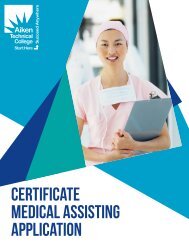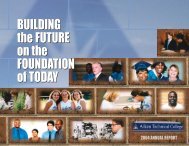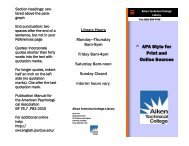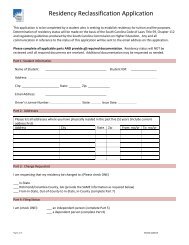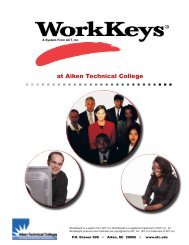2009 Accountability Report - Aiken Technical College
2009 Accountability Report - Aiken Technical College
2009 Accountability Report - Aiken Technical College
You also want an ePaper? Increase the reach of your titles
YUMPU automatically turns print PDFs into web optimized ePapers that Google loves.
28<br />
The data is collected and disseminated to the appropriate individuals and program improvement is made based<br />
on the results.<br />
The college utilizes the Community <strong>College</strong> Survey of Student Engagement (CCSSE) to measure the extent to<br />
which students are “engaged” in their own learning. Benchmark data are analyzed around five major<br />
categories: Active and Collaborative Learning; Academic Challenge; Student Effort; Student-Faculty<br />
Interaction; and, Support for Learners. Within the Academic Challenge benchmark the <strong>College</strong> is able to<br />
analyze student achievement related to the seven Core Institutional Learning Outcomes. Student and faculty<br />
responses are compared and gaps identified around which intervention strategies can be developed and<br />
implemented.<br />
III.3.4. How do you determine student and stakeholder satisfaction and dissatisfaction and use this<br />
information to improve<br />
In addition, to an “open, informal” opportunity to discuss concerns with <strong>College</strong> administrators, students can<br />
provide feedback in formal surveys and instruments utilized by the <strong>College</strong> for formal feedback (i.e. CCSSE<br />
survey, New Student Survey, Graduation Survey). Surveys or personal calls are sent or made to students who<br />
no longer attend the institution to determine if the barriers that exist can be removed to enable continued<br />
enrollment. To determine the effectiveness of the services of the <strong>College</strong>, an annual Customer Services Survey<br />
is completed by students using any of the services provided through the Student Services division during the<br />
November-December time period. Recent results demonstrate an 83 percent ‘excellent’ rating and an 11<br />
percent ‘above average’ rating for the division.<br />
The Education Division conducts a student survey at the end of each course or program. The 5-point scale<br />
indicates a level of satisfaction (Very Dissatisfied, Dissatisfied, Satisfied, Very Satisfied, and N/A). Data is<br />
collected and disseminated following each semester for review. In 2008, the college established an<br />
improvement plan process for faculty not meeting the 3.0 satisfaction threshold which is tied into faculty FMPS.<br />
Faculty that do not meeting the satisfaction threshold meet with their respective department chair/program<br />
coordinator, and develop an improvement plan that is carefully monitored to track improvement.<br />
The <strong>College</strong> conducts the Community <strong>College</strong> Survey of Student Engagement (CCSSE) on an annual basis to<br />
provide useful information on student engagement and satisfaction. Results from the <strong>2009</strong> survey regarding<br />
students’ evaluation of their overall educational experience at ATC are found in Category 7.<br />
III.3.5. How do you build positive relationships to attract and retain students and stakeholders, to enhance<br />
student performance, and to meet and exceed their expectations for learning Indicate any key distinctions<br />
between different student and stakeholder groups.<br />
Positive relations between the <strong>College</strong> and students are handled in a variety of ways. First is the relationship<br />
between a student and a faculty member. Academic advising is conducted by all faculty at ATC. In most<br />
technical programs, the advisor is the program coordinator and often the primary instructor. To further enhance<br />
the advisement process the <strong>College</strong> has employed three dedicated academic area advisors for the Pre-Allied<br />
Health, Pre-Nursing and <strong>Technical</strong> programs. This relationship can be a positive influence in the student’s


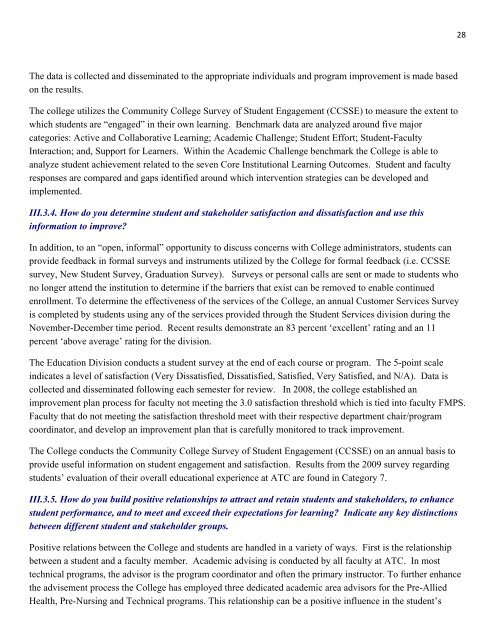
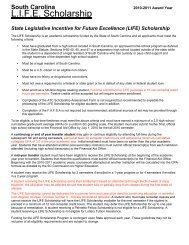
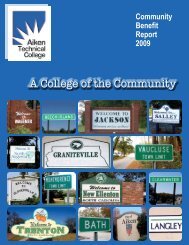
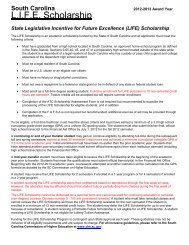
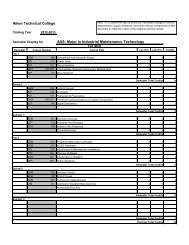

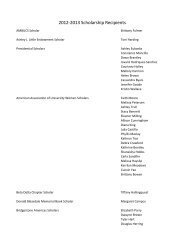
![MLA PowerPoint presentation [PDF] - Aiken Technical College](https://img.yumpu.com/36398339/1/190x143/mla-powerpoint-presentation-pdf-aiken-technical-college.jpg?quality=85)
